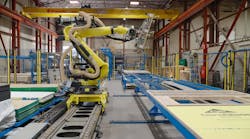The Internet of Things (IoT) is changing the way people monitor, interact with, and control various applications. From security systems to thermostats, the IoT is taking convenience to another level. In the case of commercial buildings, owners and managers no longer have to fear they may have forgotten to lock the door, re-set the thermostat, or activate the alarm system at the end of the day; with the ability to control building systems remotely with a smartphone, tablet, or computer, peace of mind can be a click away. What’s more, with IoT technology, building owners and managers have the ability to reduce operating expenses and positively impact their organization’s bottom line. For example, they can control HVAC depending on occupancy and regulate airflow on a plant floor as shift schedules change.
From an engineering standpoint, a critical component of devices enabling operators to log on from a remote location and control various aspects of their buildings is the printed circuit board (PCB). A customized PCB connects electronic components in a way allowing controllers operating different IoT applications to work.
There are two distinct styles of PCBs:
- Through-hole. The first PCBs utilized through-hole technology, whereby components are mounted by lead wires inserted through holes on one side of a board and soldered onto copper traces on the other. Because of the large number of holes and the precision with which the holes need to be drilled, PCBs utilizing through-hole technology can be costly.
- Surface-mount. As demand for smaller and lighter-weight PCBs increased, surface-mount technology gained momentum and today is the predominant design. With surface-mount technology, small metal tabs or end caps are soldered onto a PCB. The placement of components on both sides of a surface-mount PCB enables much smaller assemblies with much higher circuit densities than are possible with through-hole PCBs.
The increased packing density of surface-mount PCB design results in more innovation, as applications never thought possible are being developed. The biggest challenge manufacturers are facing with surface-mount technology on PCBs is finding individuals capable of meeting the required specs, as the engineering requires a great amount of skill and precision.
Another element of the design of a PCB is the microprocessor. The amount of memory required for a microprocessor is dependent on the complexity of the system. For example, is a thermostat being controlled by Wi-Fi, Bluetooth, or radio frequency?
As the world continues to become more hands-free, more connected, and more expedient, seamless control is becoming a greater priority. As technology continuously evolves, the engineers designing PCBs will continue to find more efficient ways to connect and control a greater number of applications.












